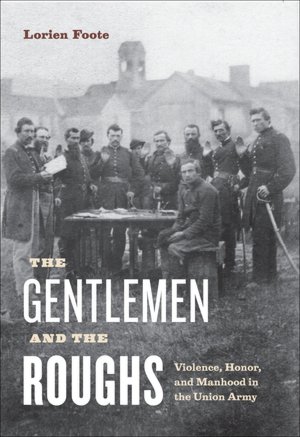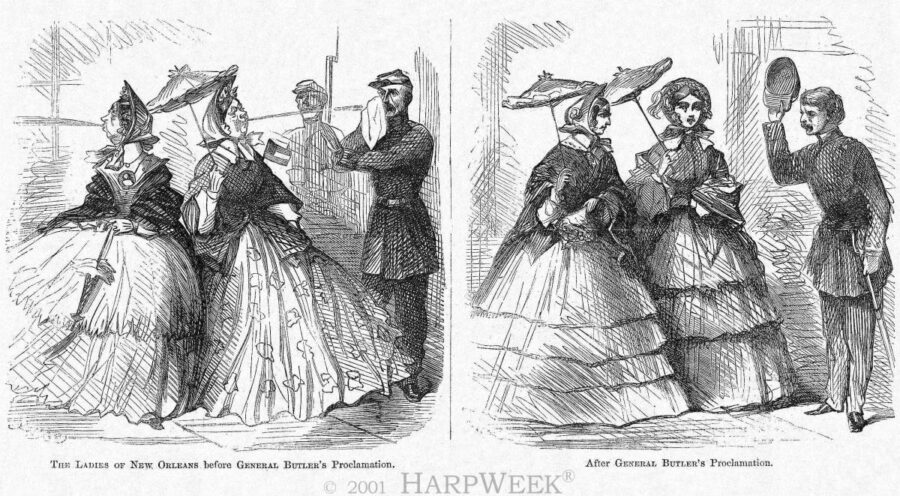The Gentlemen and the Roughs: Violence, Honor, and Manhood in the Union Army by Lorien Foote. New York University Press, 2010. Cloth, ISBN: 0814727904. $39.00.
 Positing the Union Army as northern society in microcosm, Lorien Foote argues for a vibrant culture of honor in the Union ranks. This northern honor operated along a sliding scale—from primal aggression to genteel decorum—that corresponded to competing visions of manhood tied to social class. “Gentlemen” officers and rank-and-file “roughs” both adhered to honor’s dictates, but those dictates reflected class-based assumptions regarding the very manhood such honor upheld. Union honor and manhood were widely understood as contestable attributes, and violence frequently accompanied these contests. The roughs brawled while their officers dueled, and Army brass disciplined the lot. The Union Army attempted to instill an essential military discipline—through court martial and regimental regulation—that reflected the contested nature of northern manhood and the competing conceptions of honor it entailed. Genteel restraint combated primal aggression in the purview of desired soldierly traits, and though Army institutions favored the former, they never fully committed to discarding the latter. Soldiers were fighters first and foremost, and both the gentlemen and the roughs lent the Union Army its collective—and disputed—honorable standard and masculine ideal.
Positing the Union Army as northern society in microcosm, Lorien Foote argues for a vibrant culture of honor in the Union ranks. This northern honor operated along a sliding scale—from primal aggression to genteel decorum—that corresponded to competing visions of manhood tied to social class. “Gentlemen” officers and rank-and-file “roughs” both adhered to honor’s dictates, but those dictates reflected class-based assumptions regarding the very manhood such honor upheld. Union honor and manhood were widely understood as contestable attributes, and violence frequently accompanied these contests. The roughs brawled while their officers dueled, and Army brass disciplined the lot. The Union Army attempted to instill an essential military discipline—through court martial and regimental regulation—that reflected the contested nature of northern manhood and the competing conceptions of honor it entailed. Genteel restraint combated primal aggression in the purview of desired soldierly traits, and though Army institutions favored the former, they never fully committed to discarding the latter. Soldiers were fighters first and foremost, and both the gentlemen and the roughs lent the Union Army its collective—and disputed—honorable standard and masculine ideal.
Foote’s analysis marches through six chapters that successively detail the spectrum of Union masculinity standards. The tug-and-pull nature of the honor and gentility ascribed to the gentleman guides every chapter, and the role played by official Army discipline in determining the meaning of these terms runs parallel throughout. Foote outlines how various elements within the Union Army and northern society at large held singular and often-contradictory views of honor, gentility, and who/what constituted a gentleman. She locates much of this tension in class divisions between the lower class and their social betters, but gives equal weight to instances where such class antagonism breaks down. Competing notions of honor and gentility figure prominently, and Foote illustrates how Union soldiers, elite and non-elite alike, employed the language and ritual of honor to settle personal disputes and resolve public controversies, even citing several previously unheralded formal duels between Union officers (93-118). Foote argues that military authorities officially condemned such violence, but frequently tolerated its existence, citing the lax disciplinary measures enacted against Union soldiers indicted for affairs of honor and the loose definition of honor employed in such cases.
The author also shows how many conscripted soldiers’ activities, deemed immoral or ungentlemanly by officers and volunteers of the upper classes, involved equally pervasive notions of lower class honor that rejected gentility outright. Regarding the upper class gentleman as effeminate, they held to a more primal masculine standard that celebrated physical prowess and encouraged its public performance, often to violent ends. Though employing much of the language and ritual associated with the formal duel, these brawls and fisticuffs provoked much harsher disciplinary punishment from authorities. Highlighting both the commonalities and divergences between such conceptions of honor, gentility, and the gentleman, and contrasting the official Army reactions, Foote vividly illustrates the inherent tensions within honor and manhood in the Union Army and northern society.
Foote engages an immense corpus of historical literature on nineteenth-century honor and manhood, relying especially upon the work of Elliot Gorn (“Gouge and Bite, Pull Hair and Scratch,” 1985), Bertram Wyatt-Brown (Honor and Violence in the Old South, 1986), Kenneth Greenberg (Honor and Slavery, 1996), and Amy Greenberg (Manifest Manhood, 2005) to define honor in its class and gendered dimensions. Foote’s argument for the vibrancy of Union honor is well founded, but in emphasizing the contrast between a complex northern and more simplistic southern conception of honor and manhood, she belies a cursory understanding of historical literature on southern honor. Bertram Wyatt-Brown’s later work on honor and grace in the South (The Shaping of Southern Culture, 2001) and Stephanie McCurry’s exhibition of the cultural connections between South Carolina yeomen and elites (Masters of Small Worlds, 1995) both warrant investigation toward rectifying this overemphasis. Foote also engages more recent literature on the Civil War as a moral conflict, most notably the work of Harry Stout (Upon the Altar of the Nation, 2007). Again, however, she fails to account for the complexity of the southern experience, as observed most vividly in the work of Beth Barton Schweiger (The Gospel Working Up, 2000), contrasting instead northern complexity with southern simplicity regarding morality, honor, and manhood.
These historiographical squabbles aside, Lorien Foote’s examination of violence, honor, and manhood in the Union Army complicates established notions of honor in nineteenth-century America and enlightens perspectives on masculine ideals in this rapidly changing society. Consulting an impressive and largely untapped reservoir of Union Army court martial records and regimental order books, Foote reveals previously untold complexities within northern manhood and illuminates the vital role honor played in making this contested manhood manifest to all within Union ranks.
James Hill Welborn III is a Ph.D. candidate in History at the University of Georgia.
